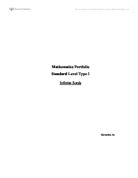Notice:
The formula to calculate the second column: B2=SQRT(1+SQRT(1)) then following to the next values will be B3=SQRT(1+B2) etc…
Plot the relation graph between n and an:
(This graph I used the software Microsoft Excel 2008 to draw)
Evaluation:As the graph shown, as the n gets very large, the values of an still be the same. Hence the value of is equal to 0. According to the data table, after the 4th term, all the data have the same until 1.61 which is 2 decimal place. And after a18, all the values are exactly have the same value 1.618033989.
As we have:
However, when it comes to exact value:
Using quadratic formula to solve this equation:
Notice: This value is canceled out because the value of a square root can not be negative.
Thus:
Consider another infinite surd:
The first term is
Calculate the decimal values of the first ten terms of this sequence:
Using MS Excel 2008
Notice:
The formula to calculate the second column: B2=SQRT(2+SQRT(2)) then following to the next values will be B3=SQRT(2+ B2) etc…
Plot the relation graph between n and an :
(This graph I used the software Microsoft Excel 2008 to draw)
Evaluation:(I repeat the entire process above)
As the graph shown, as the n gets very large, the values of an still be the same. Hence the value of is equal to 0. According to the data table, the a8, a9 and a10 already have the same value 1.99999, equivalent until 5 decimal place.And after 15th term, all the value are exactly the same values 2.
As we have:
However, when it comes to exact value:
Using quadratic formula to solve this equation:
Notice: This value is canceled out because the value of a square root can not be negative.
Thus:
Consider the general infinite surd:
The first term is:
The an+1 term in term of an:
An expression for the exact value of this general infinite surd in terms of k:
Using quadratic formula to solve this equation:
Thus:
The exact value of this general infinite surd in terms of k is:
As we can see the value of an infinite surd is not always an integer.Example:
Table shows the first ten terms of this infinite surd:
(Using MS Excel 2008)
Notice:
The formula to calculate the second column: B2=SQRT(3+SQRT(3)) then following to the next values will be B3=SQRT(3+ B2) etc…
Therefore, the value of an infinite surd is not always an integer.
To find some values of k that makes the expression an integer
1st method
Hence, we will have this equation for the relation between an and k:
Therefore the general statement for k is a product of two consecutive integers.
2nd method
Or I can use another method to prove this general statement and also check the result of it.
Back to the , for an to be integer, must divided-able by 2 which are even number. Therefore, must be odd number. And must be a perfect square, if not the result value will be irrational number.
Here are the table showing the first 50th term of perfect square:
As we can see all the odd number perfect square will have an odd number as a result. Let call v2 is the sum of which v is an odd integer.
Then:
[1]
Which is even number, and divided-able by 4. And is an odd number, also an odd number
Formula of an odd number: [2]
(u is a random integer number)
From [1] and [2] we have:
Hence the general statement for k is a product of two consecutive integers.
Checking the general statement that represents all the values of k for which the expression is an integer using the 1st method.
If
This infinite surd is
Table shows the first ten terms of this infinite surd:
(Using MS Excel 2008)
Notice:
The formula to calculate the second column: B2=SQRT(6+SQRT(6)) then following to the next values will be B3=SQRT(6+B2) etc…
After checking the values table of the infinite surd and . Hence, the general statement that represents all the values of k for which the expression is an integer is correct.
Now I will test the 2nd method using a greater number, for example 99
If
This infinite surd is
Table shows the first ten terms of this infinite surd:
(Using MS Excel 2008)
Notice:
The formula to calculate the second column: B2=SQRT(9900+SQRT(9900)) then following to the next values will be B3=SQRT(9900+B2) etc…
Therefore, the 2nd method also correct as which the exact value is 100, an even and divided-able by 2 integer.
III. Conclusion:After all the tests and checking the general statement, they prove that my result are true and correct for all the values of k. Nonetheless, I have also solved the other questions at the beginning of this portfolio and found the general formula for the exact value of this and this infinite surds in particular and this surd formula in general with difference method and examples. As this part, I have done all the question of the mathematics portfolio for IB students ‘Infinite Surd’/







